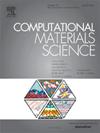陶瓷气凝胶微观结构-性能不确定性传播的随机深度学习代理模型
IF 3.3
3区 材料科学
Q2 MATERIALS SCIENCE, MULTIDISCIPLINARY
引用次数: 0
摘要
本研究提出了一个集成的计算框架,在给定合成参数的情况下,通过将基于物理的模拟与深度学习代理模型相结合,预测陶瓷气凝胶多孔材料的微观结构形态和力学响应。采用晶格玻尔兹曼模拟方法模拟材料合成过程中微观结构的形成,采用有限元模型计算材料的力学性能。为了克服表征微观结构随机性对力学性能影响所需的重复物理模拟的令人生畏的计算需求,使用卷积神经网络(cnn)开发了替代模型,用于微观结构生成和微观结构-性能映射。CNN训练被表述为一个贝叶斯推理问题,在基于物理的模拟提供的有限训练数据下,实现不确定性量化,并提供代理模型预测的置信度估计。数值结果表明,该模型能在更大的域上有效地生成与训练数据形态一致的微观结构图像。贝叶斯CNN代理准确预测分布中微结构的应变能,并进一步研究了其对插值形貌的泛化能力。最后,采用代理模型进行不确定性有效传播,量化微观组织变化对宏观力学性能的影响。本文章由计算机程序翻译,如有差异,请以英文原文为准。

Stochastic deep learning surrogate models for uncertainty propagation in microstructure–properties of ceramic aerogels
This study presents an integrated computational framework that, given synthesis parameters, predicts the resulting microstructural morphology and mechanical response of ceramic aerogel porous materials by combining physics-based simulations with deep learning surrogate models. Lattice Boltzmann simulations are employed to model microstructure formation during material synthesis process, while a finite element model is used to compute the corresponding mechanical properties. To overcome the prohibitive computational demands of repeated physics-based simulations required for characterizing the impact of microstructure randomness on mechanical properties, surrogate models are developed using Convolutional Neural Networks (CNNs) for both microstructure generation and microstructure–property mapping. CNN training is formulated as a Bayesian inference problem to enable uncertainty quantification and provide confidence estimates in surrogate model predictions, under limited training data furnished by physics-based simulations. Numerical results demonstrate that the microstructure surrogate model effectively generates microstructural images consistent with the morphology of training data across larger domains. The Bayesian CNN surrogate accurately predicts strain energy for in-distribution microstructures and its generalization capability to interpolated morphologies are further investigated. Finally, the surrogate models are employed for efficient uncertainty propagation, quantifying the influence of microstructural variability on macroscopic mechanical property.
求助全文
通过发布文献求助,成功后即可免费获取论文全文。
去求助
来源期刊

Computational Materials Science
工程技术-材料科学:综合
CiteScore
6.50
自引率
6.10%
发文量
665
审稿时长
26 days
期刊介绍:
The goal of Computational Materials Science is to report on results that provide new or unique insights into, or significantly expand our understanding of, the properties of materials or phenomena associated with their design, synthesis, processing, characterization, and utilization. To be relevant to the journal, the results should be applied or applicable to specific material systems that are discussed within the submission.
 求助内容:
求助内容: 应助结果提醒方式:
应助结果提醒方式:


